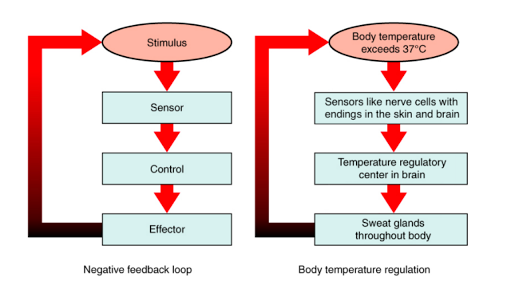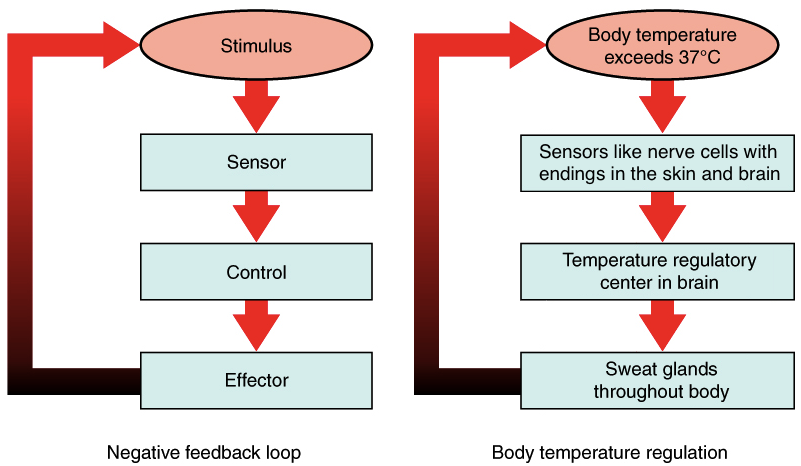Describe the Process of Biological Homeostasis Using Negative Feedback
A negative feedback loop also known as an inhibitory loop is a type of self-regulating system. The primary mechanism of homeostasis is negative feedback in which a stimulus resulting from a change in the external or internal environment triggers a response that compensates for the change.

Homeostasis Article Feedback Khan Academy
This includes three elements.

. The maintenance of a relatively stable internal environment by an organism in the face of a changing external environment and varying internal activity using negative feedback mechanisms to minimize an error signal. A negative feedbackshow more content. Negative feedback is a vital control mechanism for the bodys homeostasis.
SOM - State of Michigan. In homeostasis negative feedback loops are most common as the body is typically attempting to decrease the effect of the stimulus to get the body back to equilibrium. Homeostasis refers to the steady state of internal conditions maintained by living organisms.
Negative feedback prevents a physiological variable or a body function from going beyond the normal range. Negative Feedback Loops. Any homeostatic process that changes the direction of the stimulus is a negative feedback loop.
Homeostasis is any self-regulating process by which an organism tends to maintain stability while adjusting to conditions that are best for its survival. In a negative feedback loop increased output from. Furthermore homeostasis is a self-regulating process that regulates internal variables necessary to sustain life.
Up to 24 cash back Three basic factors to the feedback system. Sets range of what the maintained balance in the body should be. If the value deviates too much.
The control center is the component in a feedback system that compares the value to the normal range. It evaluates the input it recieves from the receptors and generates command outputs when. Negative feedback occurs when a systems output acts to reduce or dampen the processes that lead to the output of that system resulting in less output.
In general negative feedback loops allow systems to self-stabilize. When any condition gets out of balance feedback loops return the body to homeostasis. Negative feedback loops are responsible for the stabilization of a system and ensure the maintenance of a steady stable.
Any homeostatic process that changes the direction of the stimulus is a negative feedback loop. The top of a normal range. In this way a negative feedback loop brings a system closer to a target of stability or homeostasis.
A negative feedback loop occurs in biology when the product of a reaction leads to a decrease in that reaction. Calcium is an essential mineral in our body needed for the maintenance of strong bones and teeth. Negative feedback loops control body temperature and the blood glucose level.
If the level of something rises control systems reduce it again if the level of something falls control systems raise it again. The maintenance of homeostasis by negative feedback goes on throughout the body at all times and an understanding of negative feedback is thus fundamental to an understanding of human physiology. Explain why homeostasis is regulated by negative feedback loops rather than positive feedback loops.
It does this by reversing a physiological variable change stimulus once the normal range is exceeded. There are two types of feedback systems. An example of negative feedback in humans in order to maintain homeostasis would be a diabetic using insulin.
A negative feedback system is the process in which part of the output of a system is returned to regulate further output. This is a natural. If its unsuccessful it results in a disaster or death of the organism.
Negative feedback is a mechanism that reverses a deviation from the set point and in turn maintains body parameters within their normal range. If homeostasis is successful life continues. Negative feedback serves to reduce an excessive response and to keep a variable within the normal range.
A negative feedback loop will work to decrease the effect of the stimulus while a positive feedback loop will increase it. A negative feedback system has three basic components aA sensor also referred to a receptor is a component of a feedback system that monitors a physiological valueThis value is reported to the control center. The bottom of a normal range.
The components of a negative feedback are the sensor or. The body maintains homeostasis by controlling a host of variables ranging from body temperature blood pH blood. The level of a sex hormone testosterone T is controlled by negative feedback.
Most control systems maintain homeostasis by a process called negative feedback. The point at which changes can no longer occur. In other words homeostasis is a mechanism that maintains a stable internal environment despite the changes present in the external environment.
Homeostatic control is achieved using negative feedback mechanisms. These feedback systems are. The stability that the organism reaches is rarely around an exact point such as the idealized.
It may either increase or decrease the stimulus but the stimulus is not allowed to continue as it did before the receptor sensed it. In contrast to negative feedback loops positive feedback loops amplify their initiating stimuli in other words they move the system away from its starting state. Negative feedback loops play an important role in regulating health in the human body.
Homeostasis is controlled by the nervous and endocrine system of mammals. In the middle of a normal range. Positive feedback loops actually push the organism further out of homeostasis but may be necessary for life to occur.
Since diabetes break the regular loop of homeostasis which breaks the function of the negative feedback system injecting insulin into the blood stream helps connect it. Most biological feedback systems are negative feedback systems. The endocrine system corrects imbalances by secreting hormones into the bloodstream.
A setpoint is usually. Humans have control centers in the brain and other parts of the body that constantly monitor conditions like temperature pressure and blood and tissue chemistry. Negative feedback that seeks a goal and responds as a consequence of failure to meet this goal maintains a stable range of values and positive feedback that produces growth processes wherein the actions build on the results that then generate still greater action a growth cycle.
It may either increase or. Homeostasis is generally maintained by a negative feedback loop that includes a stimulus sensor control centre and effector. Homeostasis typically involves negative feedback loops that counteract changes of various properties from their target values known as set points.
Monitors change and sends message to the control centre in the form of a chemical signal or a nerve impulse.

Homeostasis Anatomy And Physiology

Homeostasis Article Feedback Khan Academy

Negative Feedback 6 4 2 Aqa A Level Biology Revision Notes 2017 Save My Exams
No comments for "Describe the Process of Biological Homeostasis Using Negative Feedback"
Post a Comment